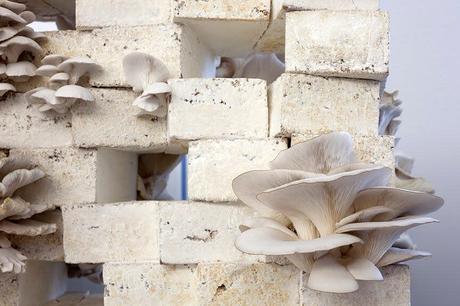
A team of Vancouver academics is combining the fields of microbiology and architecture to create living building materials made from oyster mushrooms and other edible fungi.
They say their research into 'engineered living materials' could help curb the high energy and environmental impact of the construction industry, replace traditional insulation or even help regulate indoor temperatures as the climate warms.
One day it could even help filter air pollutants like wildfire smoke, according to a postdoctoral researcher at the University of BC.
"This idea of artificial living materials is a very new concept," says Nicholas Lin, an engineer with expertise in microbiology.
"These materials are synthesized by combining raw materials with living cells and exhibit some certain properties of living systems," explains Lin, whose research spans both UBC's microbiology and architecture schools.
His teammates at UBC's Biogene Architecture Lab are creating various building materials filled with mycelium: the fuzzy-looking network of small, pale underground strands, or hyphae, that perform a function similar to plant roots.
But fungi, one of the oldest organisms on Earth at more than a billion years old, are neither plants nor animals.
The team of researchers mainly works with edible species, such as oyster, reishi and turkey tail mushrooms.
"Oyster is probably the most popular because we know it is edible, there is no known toxicity and it grows very quickly," Lin said.
'Dynamic, tunable'One of his supervisors is associate professor of architecture Joseph Dahmen.
Dahmen said his main inspiration during his years of research into what he calls "mycelium biocomposites" was to reduce the energy and environmental impact of building materials.
"The lion's share of the energy that goes into buildings is in the materials themselves," he told CBC News. "Mycelial biocomposites provide a type of biodegradable material to replace these."
The story continues
To make the artificial living materials - whether bricks, gels that can take any shape, insulation material or drywall-like sheets - he says the researchers mix mushroom spores with something rich in cellulose, often a recycled or by-product material such as sawdust, wheat chaff . or rice husks.
A 3D printer at the University of BC creates layers of a hydrogel solution infused with reishi mushroom mycelium, a network of thin strands known as hyphae that are equivalent to the roots of fungi. (Submitted by UBC Biogenic Architecture Lab)
Although this has been done around the world for years with both fungi and bacteria, he explained, the end product is often "cooked" to kill the organisms.
"We didn't invent the process," he said. "But what we're really interested in is the potential of these materials if left alive.
"So you can imagine a material that then becomes dynamic and tunable. We can make it different strengths. It keeps growing."
Oyster mushrooms grow from stones formed from mycelium. They were used to build a wall for an art installation created by AFJD, the design studio of Joe Dahmen and his wife Amber Frid-Jiminez. (AFJD)
'Grows like mushrooms'While Lin killed microorganisms by creating antibacterial surfaces during his PhD research, he now uses 3D printers to create a gel full of them.
"It's basically the same thing: killing something and raising it again," he mused. "Some parts of it are quite similar in terms of how you maintain a pure culture.
"But one thing that's always very interesting is that if we neglect the fungi, or if we forget to look at them, sometimes a little oyster mushroom comes out of it."
Because the fast oyster and other fungi can spread, the researchers can quickly test new ideas.
And that's led the UBC lab to develop everything from a mushroom-based composting toilet to solid sawdust bricks and benches.
"The expression 'grows like mushrooms' is actually correct," Dahmen joked. "They grow very quickly and are usually hydrophobic, so they can repel water.
"We can tailor them to the unique environmental considerations for where we want to deploy them."
A microscope image shows mycelium, the equivalent of roots for mushrooms, spreading or inoculating a growing bag in a University of BC laboratory. (Submitted by UBC Biogenic Architecture Lab)
Dahmen said an entire house made from 3D-printed living mushrooms is purely hypothetical at this point.
"I would say we're probably still a few years away from integration into mainstream buildings," he said. "But we are only now beginning to understand some of the possibilities of these materials."
Built-in climate controlLin said there are some even more complex functions the future could hold for living building materials - based on what he called the "environmental responsiveness" of fungal hyphae.
A study published in the journal Proceedings of the National Academy of Sciences This year found that mushrooms can lower their temperatures an average of 3 degrees below their ambient temperatures - which, Lin said, could point to climate control applications as the climate warms.
And with climate change worsening wildfires in Canada, living materials filled with mold may one day help purify the air in our homes.
"Can we engineer these mushrooms so that if there's a lot of smoke from forest fires, they can recognize it and produce more of these fibrous, fluffy materials to trap these particles?" he speculated.
That's an idea that's still largely science fiction, but Lin believes it needs further research.
"In the very distant future, these biological tools could give us new ways and new insights to produce materials that are faster, better and cheaper - and more environmentally responsible in the long run," he said.
An architectural artist's rendering of a hypothetical house built using 3D printed biocomposite materials filled with microscopic networks of fungal mycelium. (Submitted by UBC Biogenic Architecture Lab)
